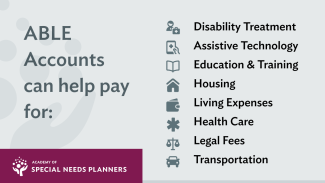
An Introduction to ABLE Accounts
Caring for a loved one with a disability can be financially challenging, especially when it comes to planning for their long-term financial security. Fortunately, ABLE accounts have emerged as a valuable financial planning tool allowing individuals with disabilities to save and invest money without jeopardizing eligibility for means-tested government benefits. In this article, we will provide an introduction to ABLE accounts and explore their benefits and considerations.
What are ABLE Accounts?
An ABLE account is a specialized savings account created by the Achieving a Better Life Experience Act of 2014, designed to help individuals with disabilities save and invest money while maintaining eligibility for means-tested government benefits such as Medicaid and Supplemental Security Income (SSI). By offering tax-advantaged and flexible savings options, these accounts provide a valuable tool for individuals with disabilities and their families to address the extra costs they often incur for disability-related expenses.
Benefits of ABLE Accounts
Tax Advantages
One of the most significant advantages of ABLE accounts is that they offer tax benefits similar to other tax-advantaged retirement accounts. The contributions to an ABLE account are made after-tax, and the earnings on the account grow tax-free. When funds are withdrawn from the account for qualified disability-related expenses, including education, housing, transportation, healthcare, and personal support services, they are also free from federal income tax. This tax-free growth can help funds grow faster, providing additional financial resources for the beneficiary's needs.
Preserving Government Benefits
One of the most critical benefits of ABLE accounts is that they allow individuals with disabilities to save and invest money without jeopardizing eligibility for means-tested government benefits, such as Medicaid and SSI. This way, individuals can enjoy the savings and investments without worrying that a sudden influx of funds would disqualify them from these crucial programs.
Flexibility in Savings
ABLE accounts offer a high degree of flexibility in savings, making them a valuable tool for individuals with disabilities and their families. The account holder can contribute up to $15,000 in a year, and friends and family members can also make contributions, up to the same limit. Depending on where the account is opened, the overall balance limit is usually between $300,000 to $500,000. For instance, when a qualifying individual with disabilities is working, they can contribute to their ABLE account using their earned income – up to an additional $12,060 per year in addition to their $15,000 contribution limit.
Control and Independence
By opening an ABLE account, individuals with disabilities gain control and independence over their financial resources. They are empowered to make decisions about how the funds are used to meet their specific needs and goals. This level of control fosters a sense of ownership and self-determination, which is crucial for individuals with special needs to live fulfilling lives.
Eligibility Requirements
To be eligible to open an ABLE account, the individual must meet the eligibility requirements, which include:
- Disability Onset: Eligibility depends on when a disability started, and it must have started before turning 26 years old.
- Disability Type: The individual must have a disability that falls into one of the eligibility categories, including a condition that is expected to last one year or more, a condition that results in a marked and severe impairment, or blindness.
- Means-Tested Benefits: The beneficiary must qualify for SSI or SSDI, or have a disability certification that meets disability severity requirements.
Considerations
When considering whether to open an ABLE account, it's important to consider other factors, including:
- Variation in State Plans: ABLE account plans vary depending on the state you are residing in, with differences in contribution limits, fees, and investment options. It’s important to research the options available in your state to choose the plan that best suits your needs.
- Impact on Means-Tested Benefits: Certain means-tested benefits may be impacted if funds in the ABLE account exceed the allowed limit; an excess of funds beyond this limit could cause ineligibility to some means-tested benefits. It is essential to maintain a careful balance between savings in the ABLE account and eligibility for critical assistance programs.
- Other Planning Options: ABLE accounts can be used in concert with other resources like special needs trusts to create a comprehensive financial plan that can accommodate the varying needs of individuals with disabilities.
Conclusion
ABLE accounts offer individuals with disabilities and their families an important financial planning tool that allows them to save and invest without worrying about jeopardizing eligibility for means-tested government benefits. The tax benefits, flexibility, and independence provided by ABLE accounts make them an attractive means of addressing the extra costs of disability-related expenses while enhancing the quality of life for the disabled individual. Understanding the eligibility requirements and other considerations, including coordination with other planning tools, is necessary to achieve the best outcomes with ABLE accounts. By empowering families and individuals with disabilities financially, ABLE accounts facilitate greater independence and control in managing their financial futures.
